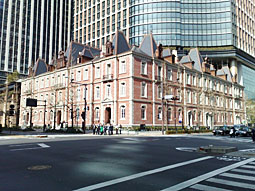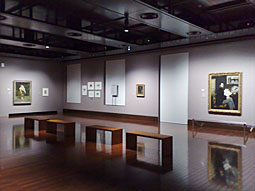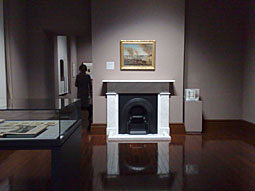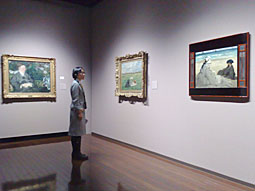 |
Focus features two in-depth reviews each month of fine art, architecture and design exhibitions and events at art museums, galleries and alternative spaces around Japan. The contributors are non-Japanese art critics living in Japan. |
|
|
 |
 |
 |
Japan's Old New Museum: The Mitsubishi Ichigokan Opens with Edouard Manet
Edan Corkill |
 |
 |
|
 |
| Mitsubishi Ichigokan Museum |
|
Installation photograph of "Manet et le Paris moderne" at the Mitsubishi Ichigokan Museum |
Every now and again stories emerge of attempts by architects, historians, or plain old concerned citizens to halt the planned demolition of some old building. The dispute invariably comes down to a conflict of priorities: the owner/developer ultimately prioritizes financial concerns (the cost of preservation is too high, the income to be gained from a preserved building is too low), while those who would halt the demolition prioritize its value as a cultural heritage to society as a whole.
Just such an argument occurred in 1968 when Mitsubishi Estate announced, and then acted on, plans to demolish the Mitsubishi Ichigokan building in Tokyo's central Marunouchi district. The building, which had been completed in 1894, was designed in the Queen Anne style by Josiah Conder, a Briton brought to Japan by the Meiji Era government to teach modern building techniques. The Mitsubishi Ichigokan was Marunouchi's first modern office building and the Mitsubishi conglomerate's first step in turning the area into a business district. The Architectural Institute of Japan believed it warranted preservation and filed two applications for the building's preservation, one of which went directly to the relevant cabinet minister (the Minister of Education). Nevertheless, Mitsubishi Estate pressed ahead and destroyed the old building -- deleting an important part of the city's (not to mention their own) history in the process. They threw up a bland modern office block in its place.
Fast-forward almost four decades, however, and Mitsubishi Estate's thinking came to match that of the Architectural Institute. In 2004 Mitsubishi announced they would faithfully reconstruct the old building, making it the jewel in the crown of a new, multi-dimensional Marunouchi complete with shopping, entertainment, cultural and historical functions (as opposed to just office buildings).
Five years and 2.3 million bricks later, the "new" version of the old building was completed, with a base-isolated structure to make it earthquake resistant. In accordance with the historical/cultural role that the building would play, the developers turned it into a museum -- the Mitsubishi Ichigokan Museum, Tokyo -- and equipped it with a recently purchased collection of Henri de Toulouse-Lautrec prints and posters. The museum opened in April this year.
The Mitsubishi Ichigokan's inaugural exhibition, however, is not of its collection. Instead, it is an impressive presentation of paintings and drawings by Edouard Manet assembled with the cooperation of the Musee d'Orsay in Paris. The highlights are the dozens of large paintings, such as Sur la plage (1873) and Chez le Père Lathuille (1879), which, with Manet's ingratiatingly casual brushwork, depict young French men and women at play.
But perhaps the best part of the exhibition, which continues until July 25, is the way that the works fit within the 19th century architectural spaces of the new building. In cosy rooms with high ceilings, fireplaces and prominent skirting boards, the luxuriantly framed artworks really do look at home -- and make viewers feel like they've been transported to another age.
How one wishes Japan had many more such architectural reminders of its Meiji Era history.
 |
|
 |
Installation photographs of "Manet et le Paris moderne" at the Mitsubishi Ichigokan Museum
All photos by Edan Corkill,
by permission of the Mitsubishi Ichigokan Museum
|
|
 |
 |
Edan Corkill
Edan Corkill is a staff writer in the arts, entertainment and features section of The Japan Times. He also edits the Japanese Art Scene Monitor, a bi-monthly email magazine published by the Australian Embassy. |
|
 |
|